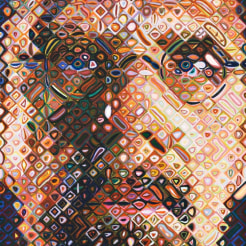John Berggruen Gallery is pleased to present an exhibition of work by American artist Chuck Close. Chuck Close: Important Works from the Past Forty Years marks the artist’s second solo exhibition at the gallery, and the first since 1999, and will be on view September 5 through November 2, 2013. John Berggruen Gallery will host an opening reception on Thursday, September 5th from 5:30 – 7:30 pm.
This exhibition focuses on several bodies of Close’s extensive oeuvre: rare drawings from the 1970s, important early prints, Polaroid maquettes, and two bodies of recent work, watercolor prints and felt hand stamps. Among the highlights of Chuck Close include an impression of Close’s first print of his career, Keith, which he produced at Crown Point Press, here in San Francisco, in 1972. Other highlights include three drawings from the 1970’s whose intimate scale demonstrate both Close’s technical mastery as well as express the conceptual foundations of his grid-based compositions. In a 1987 interview, Close revealed the systematic execution of his works to be “an invention of means. I invent thousands of little solutions to myriad problems every day, rather than the big solution, and, in that way, the whole problem eventually gets solved.”[i] Close’s relationship to photography and the historical innovation inherent in its usage is explored in Self-Portrait (Maquette) as the viewer witnesses the beginning of what will become a visual relationship between technology (the Polaroid) and painting. The watercolor prints and felt hand stamps each introduce a new technique; together, the two create a new conversation between the digital and the analogue, between the human and the mechanical. The watercolor prints mark the artist’s first in-depth experimentation with the possibilities of digital technology. Close uses approximately 14,500 of his own, hand-made watercolor marks, individually scanned in the computer, as the vocabulary for these works. Close organizes each image, and prints the works in watercolor on watercolor paper in layers of magenta, cyna, and yellow, never repeating a mark more than six times in each print.
Chuck Close (born 1940) began his career in 1968 with a black-and-white self-portrait painted from a photograph. This was the first note of the signature style which permeates his work. Since then Close has used a variety of media to create stark, hyperrealist portraits. They are closely cropped to eliminate body language and background, inviting the viewer’s attention. Close creates portraits by a process of transposing marks with a grid for reference. He explores a multitude of approaches to depicting his subjects, challenging himself by using materials and techniques that do not easily produce such realistic effects. Close immerses himself in the every aspect of his artistic process, from organization, to composition to execution. Each square is meticulously planned and every mark applied by Close. Close’s work investigates the history of the relationship between the roles of photographer and painter. Close begins every work using a photograph but defers to precise technique to execute his compositions. Among the media Close has investigated are etching, aquatint, lithography, ink and fingerprints, traditional Japanese woodcut and reduction linocut.
Chuck Close (b. 1940, Monroe, WA) received his M.F.A from Yale University and a B.A. from University of Washington in 1962. Close’s work can be found in over 65 major public collections worldwide, including the Albright-Knox Art Gallery, Buffalo; Art Gallery of Ontario, Toronto; The Art Institute of Chicago; Australian National Gallery, Canberra; Carnegie Institute, Museum of Art, Pittsburgh; The Cleveland Museum of Art; Des Moines Art Center; High Museum of Art, Atlanta; Hirshhorn Museum and Sculpture Garden, Washington DC; International Museum of Photography, George Eastman House, Rochester; Library of Congress, Washington, DC; The Metropolitan Museum of Art, New York; Musée national d’art moderne, Centre Georges Pompidou, Paris; Museum moderner Kunst, Palais Liechtenstein, Vienna; The Museum of Modern Art, New York; National Portrait Gallery, Washington DC; Osaka City Museum; Philadelphia Museum of Art; Seattle Art Museum; Staatliche Museum, Berlin; Virginia Museum of Fine Arts, Richmond; Walker Art Center, Minneapolis; Whitney Museum of American Art, New York; and Yale University Art Gallery, New Haven, among others. Close lives and works in New York.
In 2000, Close was presented with the prestigious National Medal of Arts by President Clinton. Close is a member of the American Academy of Arts and Letters, has served on the board of many arts organizations, and was recently appointed by President Obama to serve on The President’s Committee on the Arts and the Humanities.
[i] The Pace Gallery 1987. Chuck Close: Drawings, Sculpture at Pace. [press release] June 19, 1987.




